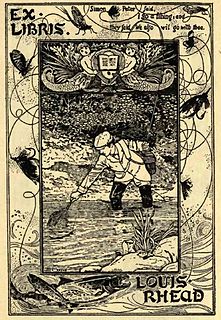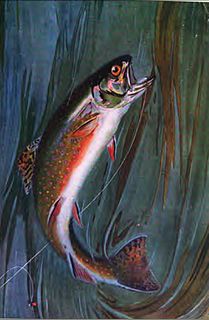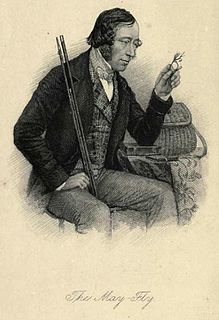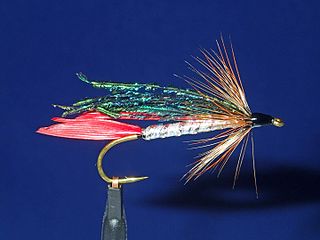
Fishing is the activity of trying to catch fish. Fish are often caught in the wild but may also be caught from stocked bodies of water. Techniques for catching fish include hand gathering, spearing, netting, angling and trapping. "Fishing" may include catching aquatic animals other than fish, such as molluscs, crustaceans, and echinoderms. The term is not normally applied to catching farmed fish, or to aquatic mammals, such as whales where the term whaling is more appropriate. In addition to being caught to be eaten, fish are caught as recreational pastimes. Fishing tournaments are held, and caught fish are sometimes kept as preserved or living trophies. When bioblitzes occur, fish are typically caught, identified, and then released.

Fly fishing is an angling method that uses a light-weight lure—called an artificial fly—to catch fish. The fly is cast using a fly rod, reel, and specialized weighted line. The light weight requires casting techniques significantly different from other forms of casting. The flies may resemble natural invertebrates, bait-fish, or other food organisms.

Recreational fishing, also called sport fishing or game fishing, is fishing for leisure, exercise or competition. It can be contrasted with commercial fishing, which is professional fishing for profit; or subsistence fishing, which is fishing for survival and livelihood.

A fishing lure is a type of artificial fishing bait which is designed to attract the attention of predatory fish, using prey-like appearances, movements, vibrations, bright reflections and flashy colors to appeal to the fish's predation instinct and entice it into striking. Many lures are equipped with one or more hooks that anchor into the fish's mouth when it bites and swallows the lure. Some hookless lures are placed to bait the fish nearer so it can can be impaled with a spear or be captured by hand.

Fly tying is the process of producing an artificial fly used by fly fishing anglers to catch fish. Fly tying is a manual process done by a single individual using hand tools and a variety of natural and manmade materials that are attached to a hook. Although the recent history of fly tying dates from the middle 1800s, fly tyers were engaged in tying flys since at least 200 AD.

Mormyshka is a sort of fishing lure or a jig. The word is derived from Russian word Mormysh meaning Freshwater Shrimp (Gammarus).

Fishing tackle is the equipment used by anglers when fishing. Almost any equipment or gear used for fishing can be called fishing tackle. Some examples are hooks, lines, sinkers, floats, rods, reels, baits, lures, spears, nets, gaffs, traps, waders and tackle boxes.

In the British Isles, coarse fishing refers to angling for rough fish, which are fish species traditionally considered undesirable as a food or game fish. Freshwater game fish are all salmonids — most particularly salmon, trout and char — so generally coarse fish are freshwater fish that are not salmonids. There is disagreement over whether grayling should be classified as a game fish or a coarse fish.

An artificial fly or fly lure is a type of fishing lure, usually used in the sport of fly fishing. In general, artificial flies are an imitation of aquatic insects that are natural food of the target fish species the fly fishers try to catch. Artificial flies are constructed by fly tying, in which furs, feathers, thread or any of very many other materials are tied onto a fish hook.

This general annotated bibliography page provides an overview of notable and not so notable works in the English language regarding the sport of fly fishing, listed by year of first publication. Although not all the listed books are devoted exclusively to fly fishing, all these titles contain significant fly fishing content. The focus of the present page is on classic general texts on fly fishing and its history, together with notable public or university library collections dedicated to fly fishing.

Fishing is a prehistoric practice dating back at least 40,000 years. Since the 16th century, fishing vessels have been able to cross oceans in pursuit of fish, and since the 19th century it has been possible to use larger vessels and in some cases process the fish on board. Fish are normally caught in the wild. Techniques for catching fish include hand gathering, spearing, netting, angling and trapping.

Frederic Maurice Halford, pseudonym Detached Badger, was a wealthy and influential British angler and fly fishing author. Halford is most noted for his development and promotion of the dry fly technique on English chalk streams. He is generally accepted as "The Father of Modern Dry Fly Fishing". John Waller Hills, A History of Fly Fishing for Trout (1921) called Halford "The Historian of the Dry Fly".

Floating Flies and How to Dress Them - A Treatise on the Most Modern Methods of Dressing Artificial Flies for Trout and Grayling with Full Illustrated Directions and Containing Ninety Hand-Coloured Engravings of the Most Killing Patterns Together with a Few Hints to Dry-Fly Fishermen is a fly fishing book written by Frederic M. Halford published in London in April 1886 by Sampson Low. A deluxe edition on large paper sold out before publication and the trade edition of 500 nearly so.

This annotated bibliography is intended to list both notable and not so notable works of English language, non-fiction and fiction related to the sport of fly fishing listed by year published. Although 100% of any book listed is not necessarily devoted to fly fishing, all these titles have significant fly fishing content. Included in this bibliography is a list of species related fly fishing literature.

This annotated bibliography is intended to list both notable and not so notable works of English language, non-fiction and fiction related to the sport of fly fishing listed by year published. Although 100% of any book listed is not necessarily devoted to fly fishing, all these titles have significant fly fishing content. Included in this bibliography is a list of fly tying, fly tackle, regional guides, memoirs, stories and fly fishing fiction related literature.

Dry-Fly Fishing in Theory and Practice (1889) is British author and angler Frederic M. Halford's second and most influential book on dry fly fishing. It followed Floating Flies and How to Dress Them (1886) and this pair of books initiated some 40 years of a rigid, and sometimes dogmatic school, the Halfordian school, of dry fly fishing, especially on English chalk streams. The work also played a significant role in the development of dry-fly fishing in America.
George Selwyn Marryat was a country gentleman and British angler most noted for his relationship with F. M. Halford, Francis Francis and the development of dry-fly fishing on the chalk streams of southern England. Upon his death in 1896, he became known as the "Prince of Fly Fishers".
The San Diego Jam knot is a common fishing knot used to tie a line to the hook, swivel, clip, or artificial fly. This knot is also known as the San Diego knot, Reverse clinch knot or Heiliger knot.

The Alexandra wet fly originated in Scotland in the 1860s. The artificial fly is also known as the Lady of the Lake, the fly was named by English angler Major William Greer Turle to honor Alexandra, Princess of Wales. The fly is distinguished by the heavy peacock herl wing and silver body which makes the fly resemble a small baitfish or fry. The Alexandra proved to be a very effective fly for trout in lakes and streams in England and Scotland in the late 19th and early 20th century. Many fly fishing purists derided the fly and its use was once banned on many English waters.
















